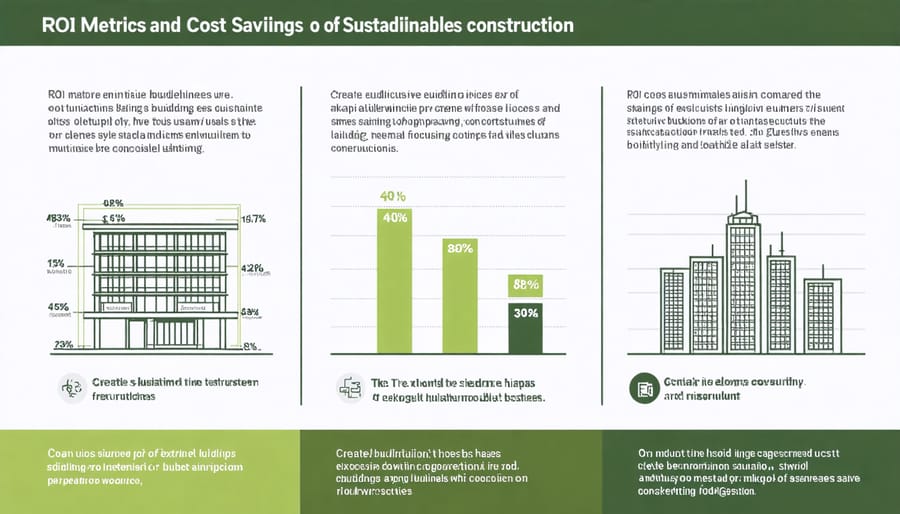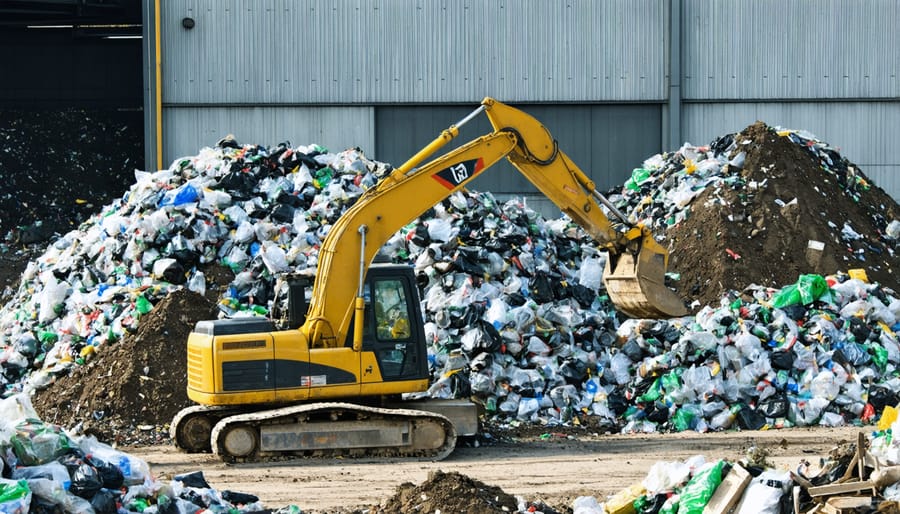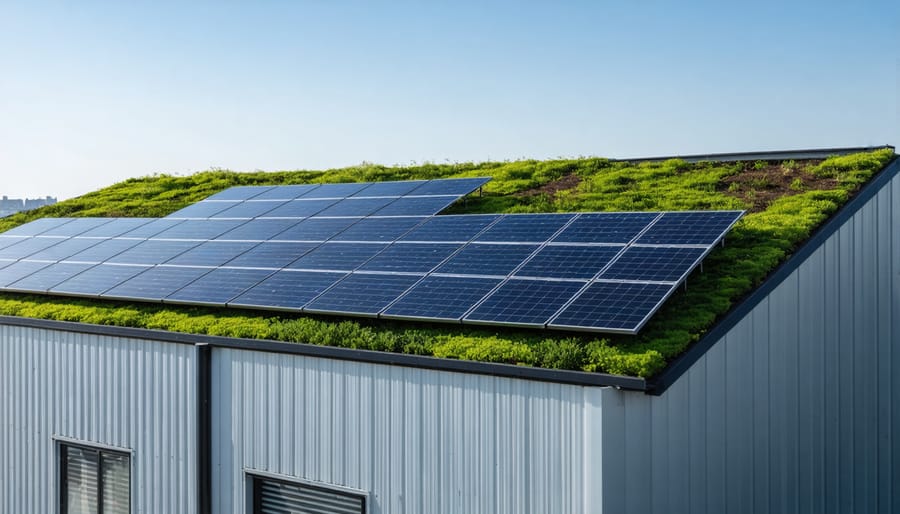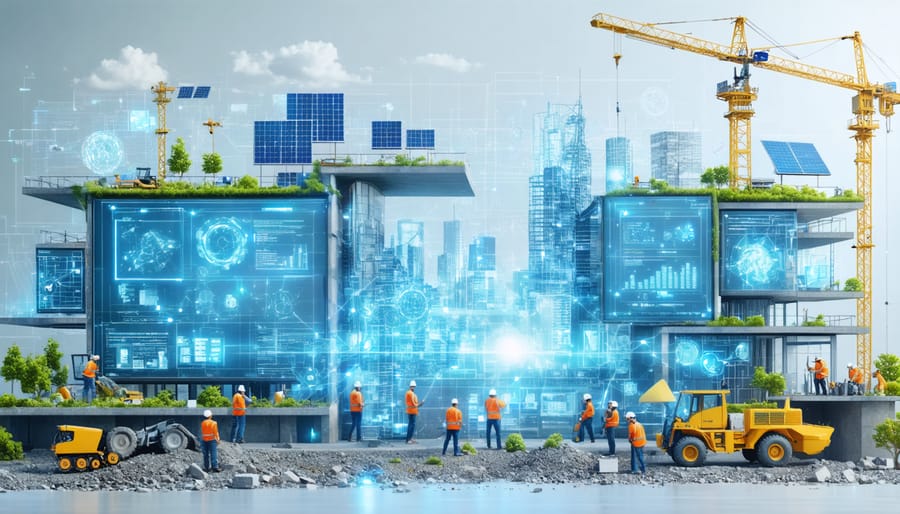Integrate sustainability metrics into critical management areas from project inception, establishing clear environmental performance indicators alongside traditional success metrics. Sustainable project development has evolved from an optional consideration to a fundamental driver of project success, market competitiveness, and long-term value creation.
Transform traditional construction workflows by implementing Building Information Modeling (BIM) with integrated sustainability analysis tools, enabling real-time environmental impact assessments and optimization of resource allocation. This digital transformation facilitates early identification of sustainability opportunities and potential conflicts, reducing rework and associated waste.
Deploy lifecycle cost analysis (LCCA) methodologies that quantify both immediate construction expenses and long-term operational benefits of sustainable solutions. Recent industry data demonstrates that projects incorporating comprehensive LCCA achieve 25-30% better resource efficiency and significantly higher return on investment over their operational lifespan.
Establish circular economy principles within supply chains by selecting materials with verified Environmental Product Declarations (EPDs), implementing waste reduction strategies, and creating closed-loop material management systems. This systematic approach ensures project sustainability extends beyond construction completion, creating lasting environmental and economic benefits for stakeholders.
The Business Case for Sustainable Project Development
Cost Benefits and Long-term ROI
Implementing sustainable project development practices yields significant financial returns through both immediate cost reductions and long-term value appreciation. Research indicates that green buildings typically demonstrate 20-30% lower operating costs through reduced energy consumption, water usage, and maintenance requirements. Effective cost management strategies in sustainable construction can lead to ROI improvements of 10-15% over traditional building methods.
Property values for sustainable buildings consistently outperform conventional structures, with studies showing premium resale values of 7-11%. Additionally, sustainable projects often qualify for tax incentives, grants, and preferential financing terms, further enhancing their financial viability. Operating cost reductions typically manifest through:
– 25-35% lower energy consumption
– 30-50% reduced water usage
– 15-20% decreased maintenance expenses
– Lower insurance premiums due to enhanced resilience
The long-term ROI calculation must also consider increased tenant satisfaction and retention rates, which typically result in higher occupancy rates and reduced vacancy periods. These factors contribute to a more stable income stream and enhanced asset value over the building’s lifecycle.

Market Demand and Competitive Edge
Market demand for sustainable construction continues to surge, driven by heightened environmental awareness and stringent regulatory requirements. Recent industry surveys indicate that 73% of commercial clients now prioritize sustainability certifications in their project specifications, creating a significant competitive advantage for firms that demonstrate strong environmental credentials.
Companies embracing sustainable project development benefit from reduced regulatory compliance costs and enhanced market positioning. By proactively adopting green building practices, organizations stay ahead of evolving environmental regulations while attracting environmentally conscious clients and investors. This approach often results in premium pricing opportunities and increased market share.
The competitive edge extends beyond immediate project benefits. Firms with established sustainable practices report improved stakeholder relationships, enhanced brand reputation, and greater success in securing government contracts. Additionally, sustainable projects typically command 7-10% higher rental rates and maintain stronger occupancy levels compared to conventional buildings.
Forward-thinking organizations are leveraging this market shift by developing comprehensive sustainability frameworks that address both environmental impact and economic viability. This strategic approach not only ensures compliance with current regulations but positions companies as industry leaders in the growing sustainable construction sector.
Core Elements of Sustainable Project Development
Resource Efficiency and Waste Management
Effective resource management and waste reduction are crucial components of sustainable project development. Optimizing material use through precise quantity surveying and advanced Building Information Modeling (BIM) can reduce waste by up to 30% while maintaining project quality.
Implementing a comprehensive waste management plan begins at the design phase, where architects and engineers can specify materials with high recycled content and modular components that minimize cutting waste. During construction, establishing dedicated waste sorting stations and partnering with specialized recycling facilities ensures maximum material recovery.
Recent industry studies show that projects utilizing prefabrication techniques typically generate 70-90% less waste compared to traditional construction methods. Key strategies include just-in-time delivery scheduling, proper material storage protocols, and regular waste audits to identify improvement opportunities.
Digital material tracking systems help monitor resource consumption in real-time, enabling project managers to identify inefficiencies and adjust procurement strategies accordingly. Best practices include:
– Implementing closed-loop material systems
– Utilizing lean construction principles
– Establishing take-back programs with suppliers
– Incorporating deconstruction considerations into design
– Maintaining detailed waste diversion records
These approaches not only reduce environmental impact but also deliver significant cost savings, with leading projects reporting 15-20% reduction in material expenses through effective resource management.


Energy Performance and Carbon Reduction
Energy efficiency remains a cornerstone of sustainable project development, with modern technologies and strategies offering significant opportunities for carbon reduction. Building Energy Management Systems (BEMS) serve as the foundation for optimizing energy consumption, utilizing smart sensors and real-time monitoring to adjust heating, cooling, and lighting systems automatically.
High-performance building envelopes incorporating advanced insulation materials, low-e glazing, and air-tight construction techniques can reduce energy demands by 30-50%. Integration of renewable energy systems, particularly photovoltaic arrays and ground-source heat pumps, further decreases dependency on grid electricity and fossil fuels.
LED lighting systems with occupancy sensors and daylight harvesting capabilities typically reduce lighting energy consumption by 75% compared to traditional systems. Variable frequency drives (VFDs) in HVAC systems optimize motor operations, resulting in 20-50% energy savings.
Passive design strategies, including proper building orientation, natural ventilation, and thermal mass utilization, complement active systems by reducing baseline energy requirements. Energy modeling software enables designers to optimize these elements during the planning phase, predicting and enhancing building performance before construction begins.
Regular commissioning and monitoring ensure systems operate at peak efficiency, while energy performance certificates (EPCs) provide standardized metrics for evaluating and comparing building energy efficiency. The implementation of these technologies and approaches typically results in 40-60% reduction in operational carbon emissions compared to conventional buildings.
Social and Environmental Impact Assessment
Social and Environmental Impact Assessment (SEIA) forms a crucial component of sustainable project development, requiring a systematic evaluation of potential effects on both communities and natural ecosystems. This comprehensive analysis encompasses direct and indirect impacts across multiple dimensions, including social dynamics, cultural heritage, biodiversity, and environmental resources.
The assessment process typically begins with stakeholder identification and engagement, involving community consultations, surveys, and expert interviews. Key social indicators examined include employment opportunities, community health and safety, cultural preservation, and economic impacts on local businesses. Environmental factors focus on biodiversity conservation, water quality, air emissions, waste management, and ecosystem services.
Modern SEIA practices employ advanced tools such as Geographic Information Systems (GIS), environmental modeling software, and social impact matrices to quantify and visualize potential effects. These assessments also incorporate cumulative impact analysis, considering the combined effects of multiple projects in the same area.
Mitigation strategies are developed based on the assessment findings, following the mitigation hierarchy: avoid, minimize, restore, and offset. Successful implementation requires continuous monitoring and adaptive management throughout the project lifecycle. Regular audits and stakeholder feedback mechanisms ensure accountability and enable necessary adjustments to mitigation measures.
Leading construction firms are increasingly adopting integrated assessment approaches that consider both social and environmental impacts simultaneously, recognizing their interconnected nature and the need for holistic solutions in sustainable development.
Implementation Framework
Planning and Design Integration
Integrating sustainability into project development requires a comprehensive approach that begins during the earliest project management phases. Successful implementation demands careful consideration of environmental, social, and economic factors throughout the planning process.
Key stakeholders should establish sustainability goals and metrics during the initial planning stage, ensuring these objectives align with both project requirements and broader organizational commitments. This includes conducting thorough environmental impact assessments, identifying potential LEED or other certification requirements, and establishing clear sustainability benchmarks.
Design teams must prioritize sustainable materials selection, energy-efficient systems, and resource conservation strategies from the outset. This involves utilizing building information modeling (BIM) to optimize design decisions and predict performance outcomes. Early integration of sustainable elements helps avoid costly retrofits and ensures maximum environmental benefit.
Environmental considerations should influence site selection, building orientation, and infrastructure planning. Teams should analyze factors such as solar exposure, natural ventilation possibilities, and local ecosystem impact. Additionally, planning should account for future climate scenarios and potential adaptability requirements.
Successful integration requires:
– Regular sustainability reviews throughout the design process
– Clear communication channels between all stakeholders
– Documentation of sustainable design decisions and their rationale
– Integration of life-cycle cost analysis in design decisions
– Establishment of measurement and verification protocols
By embedding sustainability considerations from project inception, organizations can achieve both environmental goals and long-term cost savings while creating buildings that benefit both occupants and the environment.
Monitoring and Performance Metrics
Effective monitoring and performance metrics are crucial for ensuring sustainable project development achieves its intended outcomes. Key Performance Indicators (KPIs) should encompass environmental, social, and economic dimensions while remaining measurable and actionable throughout the project lifecycle.
Essential environmental metrics include energy consumption (kWh/m²), water usage (liters/occupant), waste diversion rates (percentage), and carbon emissions (CO2e). These should be tracked against established baselines and industry benchmarks to evaluate progress effectively.
Social sustainability metrics focus on community impact, worker safety rates, local employment percentages, and stakeholder engagement levels. Economic indicators typically include lifecycle cost analysis, return on sustainable investments (ROSI), operational cost savings, and maintenance efficiency ratios.
Implementation requires robust monitoring systems:
– Real-time energy management systems
– Smart water meters
– Waste tracking software
– Indoor environmental quality sensors
– Occupant satisfaction surveys
– Safety incident reporting mechanisms
Data collection should follow standardized protocols aligned with certification requirements such as LEED, BREEAM, or Green Star. Regular reporting intervals (monthly, quarterly, and annual) ensure timely identification of performance gaps and correction opportunities.
Performance dashboards combining these metrics provide stakeholders with comprehensive project health assessments. Advanced analytics can identify trends, predict potential issues, and suggest optimization strategies.
Success criteria should be established during project planning, with clear targets for each metric. Regular stakeholder reviews ensure accountability and facilitate continuous improvement through data-driven decision-making. Third-party verification adds credibility to reported results and helps maintain transparency throughout the project lifecycle.
Case Study: The Future of Sustainable Construction
The Bullitt Center in Seattle, Washington, stands as a testament to what’s possible in sustainable construction, achieving the ambitious Living Building Challenge certification and setting new standards for eco-friendly development. Completed in 2013, this six-story, 52,000-square-foot commercial building is the world’s first certified Living Building of its size and demonstrates how sustainable project development can be both environmentally responsible and commercially viable.
The project team, led by the Bullitt Foundation and Miller Hull Partnership, implemented several groundbreaking sustainable features. The building generates 60% more energy than it consumes through a rooftop solar array, despite Seattle’s notorious cloudy climate. A rainwater harvesting system captures and treats precipitation for all non-potable uses, while composting toilets eliminate sewage output and create valuable agricultural nutrients.
The building’s success is quantifiable: it has maintained net-positive energy production for eight consecutive years, uses 82% less energy than typical Seattle office buildings, and has achieved 100% waste diversion during both construction and operation. The project’s initial construction cost of $32.5 million has been offset by negligible operational costs and premium rental rates, proving the business case for sustainable development.
Key success factors included:
– Early stakeholder engagement and integrated design process
– Performance-based contracts with suppliers and contractors
– Extensive use of locally sourced materials
– Rigorous waste management during construction
– Real-time monitoring systems for performance optimization
The Bullitt Center has influenced building codes and policies across North America, demonstrating that net-zero energy and water usage are achievable goals in commercial construction. The project’s success has inspired similar developments globally, with over 200 design teams visiting annually to learn from its implementation strategies and outcomes.
The future of construction lies firmly in sustainable project development, with emerging technologies and innovative practices continuing to reshape the industry. As we’ve explored, successful sustainable projects require a holistic approach combining environmental stewardship, economic viability, and social responsibility. The integration of digital tools, advanced materials, and smart building systems has made sustainable construction more achievable and cost-effective than ever before. Moving forward, industry leaders must prioritize renewable energy integration, waste reduction, and circular economy principles while maintaining focus on project profitability and stakeholder value. The growing demand for green buildings, coupled with increasingly stringent environmental regulations, suggests that sustainable project development will not just remain a trend but become the standard operating procedure for construction professionals worldwide. Success in this evolving landscape will depend on continuous learning, adaptation, and commitment to sustainable practices at every project phase.

